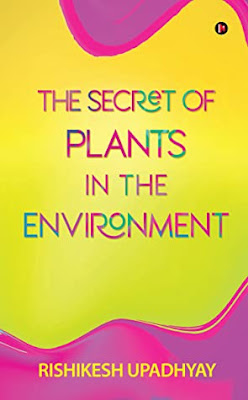I love science and in particular biology. While I read a lot of different biological subjects my favorite are about animals, plants, and the environment. It's been a while since I read a book about plants so I was really looking forward to The Secret of Plants in the Environment by Rishikesh Upadhyay.
Amazon affiliate links are used on this site. A free book was provided for an honest review.
 |
| April 2020; Notion Press; 978-1648509209 ebook, print (204 pages); science |
I'm glad that it was short, otherwise I might have given it up. There were numerous grammatical and typographical errors that I found distracting. The book really could have used another round of editing or at least a detailed proofread. In addition to numerous instances of the subject and verb not agreeing and abbreviations being used without stating what the abbreviation means, scientific names are often written incorrectly. For example, "In A. Thaliana, UV-B causes damage..." (p128). Also, as this is the first instance of this species in this chapter the genus should be spelled out (Arabidopsis). Again, I appreciate there being a list of used abbreviations, I shouldn't need to flip to the list when an abbreviation is used the first time. It is standard in scientific literature to give the full wording before using the abbreviation.
I'm not sure if the author was clear on who his target audience is - it's a bit too scientific for a general audience but I'm not sure there is enough evidence of scientific rigor to satisfy researchers. Maybe it could be used as an undergraduate textbook, but the literary quotes that start each chapter seem odd for a textbook. At times, I felt like I needed a periodic table: "The use of manures increased the availability of Fe and Mn several fold under flooded conditions." (p 109). While I remember that Fe is for iron, I struggled to remember what Mn stood for. The same goes for many of the scientific plant names. I would have liked for there to have been given some description if it didn't have a generic name so that I would know what plant was being discussed.
I assumed from the title that the plants being discussed were in the natural environment. Instead, the book is heavily focused on agricultural food crops. So it wasn't quite as interesting to me.
I never could figure out what the secret of plants was. A lot of material is covered in a very brief overview kind of way. I would have preferred that the author have dug deeper into some of the studies mentioned at the end of the chapters. It was maddening to read "many studies by so and so have been conducted" without any real commentary on those studies. Particularly it was frustrating in chapters where it was stated that the why of the mechanism is unknown. The author didn't even offer a hypothesis and I'm sure there are scientists that have hypotheses about these unknowns.
The book has potential and perhaps people who are working in this area of study will find it more to their liking than I did.
Buy The Secret of Plants in the Environment at Amazon
Donna Huber is an avid reader and natural encourager. She is the founder of Girl Who Reads and the author of how-to marketing book Secrets to a Successful Blog Tour.
Get even more book news in your inbox, sign up today! Girl Who Reads is an Amazon advertising affiliate; a small commission is earned when purchases are made at Amazon using any Amazon links on this site. Thank you for supporting Girl Who Reads.



















0 comments:
Post a Comment